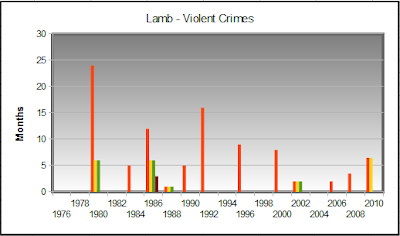People base their expectations of future events on their observations of prior events. It is a principle that Thomas Bayes, a Presbyterian Minister with a fondness for mathematics, expressed in an elegant formula over 250 years ago, and may help explain why at least three girls are dead today.
James Turner did us a favour by posting Shawn Lamb's rap sheet on his blog. Click here. It provides a great amount of insight into how somebody could end up as a career criminal, with the assistance of the criminal justice system.
In 1976, Lamb as a teenager got his first taste of jail with a 6 month sentence for theft over $200. In 1979 he was convicted twice of break, enter and theft with sentences of 9 months and then 6 months in jail. I do not know how much of that he actually served.
It does not get better. Over the years he committed many other thefts and frauds with ever-decreasing sentences ...
1984 theft under $200: 1 month in jail.
1987 theft over $1000: 5 months less a day, concurrent with other sentences.
1990 uttering a forged document: 30 days
1990 theft under $200: 15 days
1990 theft over $1000: 3 months
1991 theft under $1000: 20 days
1991 theft under $1000: 20 days
1991 theft under $1000: 10 days
1997 theft under $5000: 3 days
He was convicted of approximately 40 crimes related to theft or fraud, and regardless of how bad his track record got, the punishment in terms of jail time never exceeded the 9 months he received as a young adult in 1979.
In 1980, Shawn Lamb graduated to violent offences with armed robbery and assaulting a peace officer (x2). He received 2 years for the armed robbery and 6 months for each assault. For all of the violent offences that followed, he never had to spend over 2 years in jail.
In 1992, he graduated once again to a more serious offence: sexual assualt. For this he was sentenced to 4 years in prison, but despite 45 previous convictions he was paroled after only 16 months behind bars, having served only 1/3 of his sentence.
I think a visual representation might help. In the following graph I show the jail-term implications, as best as I could determine based on the data on James' blog, of violent crimes for which Lamb was convicted. My somewhat arbitrary grouping includes assaults, weapons offences, uttering threats and break & enter with violence.
Though the severity of the offences and the jail terms incurred vary, it is a stunning pattern. Not only did the offences not get harsher as his rap sheet got longer, but if anything the opposite occurs.
If you wanted to breed a career criminal, Lamb's sentencing history would make a perfect template. It is a demonstration that criminal history means nothing. Repeat offences are not discouraged with higher penalties. Using the innate Bayesian inference that we all use, Shawn knew what punishment to expect when committing another robbery or assault or other crime: the same sentence he got last time, give or take ... the same punishment that didn't work every other time.
It is a pattern that firmly embedded Shawn in a criminal lifestyle, so deeply that he could do nothing but plunge further in. It should be a surprise to nobody that he would graduate once again to murder, as he is alleged to have done.
Many people argue that jail time does not work, and that we should focus on alternative measures. Those people could point to this pitiful record and claim it as evidence. See! He's been in jail dozens of times and keeps re-offending. Jail doesn't work! That would be the absolute wrong conclusion to take away from this. The conclusion should be: jail time doesn't work as a disincentive when you don't use it properly.
What is desperately required is sentencing that takes into account behavioural science, or even just basic common sense. Supposing Lamb's jail terms increased significantly with each subsequent conviction for a similar crime. Lamb's expectations would have adapted accordingly. He would know that if he gets caught again he would have to suffer a yet-harsher penalty. Perhaps he would have refrained from committing the additional offence, and the one after that and the one after that. Perhaps he would have not graduated to violent crimes. At the very least he would have spent more time behind bars where he would not have had the opportunity to commit crimes. And ... perhaps the three girls would still be alive.
___________________________________________________
The graph groups convictions in 2 year increments. Prison terms that were shorter than a month I rounded up to a month so that they're more visible on the graph. When a single sentence was give for multiple crimes, I divided the sentence up among the crimes. The time served before parole was used for the sexual assault. For all other crimes the actual sentence was used.




No comments:
Post a Comment